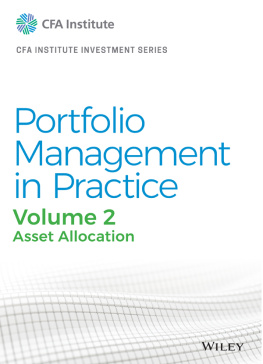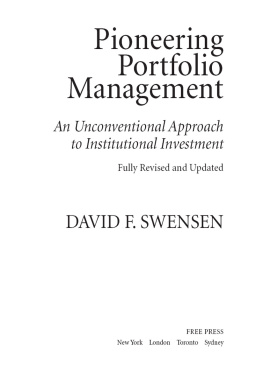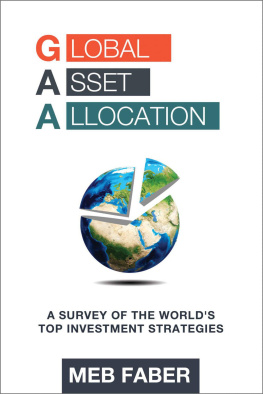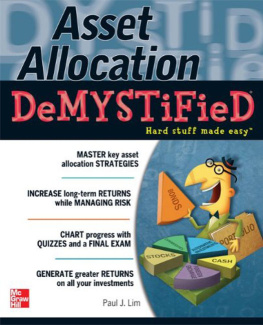Ferri - All about asset allocation: the easy way to get started
Here you can read online Ferri - All about asset allocation: the easy way to get started full text of the book (entire story) in english for free. Download pdf and epub, get meaning, cover and reviews about this ebook. City: New York, year: 2011;2010, publisher: McGraw Hill Professional, genre: Business. Description of the work, (preface) as well as reviews are available. Best literature library LitArk.com created for fans of good reading and offers a wide selection of genres:
Romance novel
Science fiction
Adventure
Detective
Science
History
Home and family
Prose
Art
Politics
Computer
Non-fiction
Religion
Business
Children
Humor
Choose a favorite category and find really read worthwhile books. Enjoy immersion in the world of imagination, feel the emotions of the characters or learn something new for yourself, make an fascinating discovery.

All about asset allocation: the easy way to get started: summary, description and annotation
We offer to read an annotation, description, summary or preface (depends on what the author of the book "All about asset allocation: the easy way to get started" wrote himself). If you haven't found the necessary information about the book — write in the comments, we will try to find it.
Ferri: author's other books
Who wrote All about asset allocation: the easy way to get started? Find out the surname, the name of the author of the book and a list of all author's works by series.
All about asset allocation: the easy way to get started — read online for free the complete book (whole text) full work
Below is the text of the book, divided by pages. System saving the place of the last page read, allows you to conveniently read the book "All about asset allocation: the easy way to get started" online for free, without having to search again every time where you left off. Put a bookmark, and you can go to the page where you finished reading at any time.
Font size:
Interval:
Bookmark:
SECOND EDITION
RICHARD A. FERRI, CFA


Copyright 2010 by The McGraw-Hill Companies, Inc. All rights reserved. Except as permitted under the United States Copyright Act of 1976, no part of this publication may be reproduced or distributed in any form or by any means, or stored in a database or retrieval system, without the prior written permission of the publisher.
ISBN: 978-0-07-175951-9
MHID: 0-07-175951-4
The material in this eBook also appears in the print version of this title: ISBN: 978-0-07-170078-8, MHID: 0-07-170078-1.
All trademarks are trademarks of their respective owners. Rather than put a trademark symbol after every occurrence of a trademarked name, we use names in an editorial fashion only, and to the benefit of the trademark owner, with no intention of infringement of the trademark. Where such designations appear in this book, they have been printed with initial caps.
McGraw-Hill eBooks are available at special quantity discounts to use as premiums and sales promotions, or for use in corporate training programs. To contact a representative please e-mail us at bulksales@mcgraw-hill.com.
This publication is designed to provide accurate and authoritative information in regard to the subject matter covered. It is sold with the understanding that the publisher is not engaged in rendering legal, accounting, securities trading, or other professional services. If legal advice or other expert assistance is required, the services of a competent professional person should be sought.
From a Declaration of Principles Jointly Adopted by
a Committee of the American Bar Association and
a Committee of Publishers and Associations
Trademarks: McGraw-Hill, the McGraw-Hill Publishing logo, All About, and related trade dress are trademarks or registered trademarks of The McGraw-Hill Companies and/or its affiliates in the United States and other countries and may not be used without written permission. All other trademarks are the property of their respective owners. The McGraw-Hill Companies is not associated with any product or vendor mentioned in this book.
TERMS OF USE
This is a copyrighted work and The McGraw-Hill Companies, Inc. (McGraw-Hill) and its licensors reserve all rights in and to the work. Use of this work is subject to these terms. Except as permitted under the Copyright Act of 1976 and the right to store and retrieve one copy of the work, you may not decompile, disassemble, reverse engineer, reproduce, modify, create derivative works based upon, transmit, distribute, disseminate, sell, publish or sublicense the work or any part of it without McGraw-Hills prior consent. You may use the work for your own noncommercial and personal use; any other use of the work is strictly prohibited. Your right to use the work may be terminated if you fail to comply with these terms.
THE WORK IS PROVIDED AS IS. McGRAW-HILL AND ITS LICENSORS MAKE NO GUARANTEES OR WARRANTIES AS TO THE ACCURACY, ADEQUACY OR COMPLETENESS OF OR RESULTS TO BE OBTAINED FROM USING THE WORK, INCLUDING ANY INFORMATION THAT CAN BE ACCESSED THROUGH THE WORK VIA HYPERLINK OR OTHERWISE, AND EXPRESSLY DISCLAIM ANY WARRANTY, EXPRESS OR IMPLIED, INCLUDING BUT NOT LIMITED TO IMPLIED WARRANTIES OF MERCHANTABILITY OR FITNESS FOR A PARTICULAR PURPOSE. McGraw-Hill and its licensors do not warrant or guarantee that the functions contained in the work will meet your requirements or that its operation will be uninterrupted or error free. Neither McGraw-Hill nor its licensors shall be liable to you or anyone else for any inaccuracy, error or omission, regardless of cause, in the work or for any damages resulting there from. McGraw-Hill has no responsibility for the content of any information accessed through the work. Under no circumstances shall McGraw-Hill and/or its licensors be liable for any indirect, incidental, special, punitive, consequential or similar damages that result from the use of or inability to use the work, even if any of them has been advised of the possibility of such damages. This limitation of liability shall apply to any claim or cause whatsoever whether such claim or cause arises in contract, tort or otherwise.
In the fall of 1929, Alfred Cowles III had an ordinary, if rather large, problem. Ordinary because, like many other Americans, he had been badly hurt by the recent stock market crash. And large because, not only was he the heir to the Chicago Tribune fortune, but he also managed it.
A highly intelligent young man, he took his charge seriously, consuming as much written analysis from the nations brokerage houses, insurance firms, and financial commentators as he could. Alas, it was in vain; none of them warned him of the impending crash. How could the countrys brightest financial stars have been so uniformly wrong?
Cowless response to the catastrophic stock market decline that wiped out nearly 90 percent of the stock markets value over the next three years, and the Great Depression that it ignited, has thundered down through the financial markets to this very day. Modern investors ignore the lessons learned by Cowles, and those who followed in his footsteps, at their own peril.
For what Cowles and his followers did was nothing less than remove finance from the realm of ignorance and superstition and place it on a scientific footing. With the help of the nations foremost economists, he founded the Econometric Society, and, along with the legendary Benjamin Graham, who had been similarly affected by the 1929 crash, he began to collect and analyze financial data in the most detailed and thoroughgoing way possible. In effect, he, and those who have followed him in the seven decades since, took investing away from the astrologers and the charlatans and gave it to the astronomers and physicists. (This is, in some cases, quite literally true: many of the finest minds of modern finance began their careers in the physical sciences.)
Unfortunately, when you pick up a financial magazine, watch CNBC, or call your broker, youve just traveled back to the pre1929 era. In fact, youve just accomplished the financial equivalent of betting the farm on the daily horoscope or of taking a rare cancer to a doctor whose main source of recent medical knowledge is USA Today.
Like most intellectual revolutions, the modern science of investing is highly counterintuitive. Do you think that it is possible, through careful securities research, to reliably select market-beating portfolios? Wrong: the data show that although many investors do so, in almost all cases this is purely the result of the randomness of the marketsin simple terms, dumb luck. People have also gotten fabulously rich buying lottery tickets; they have also gotten off scot-free without ever wearing a seatbelt. That does not make either activity a good idea. Do you think that, by choosing a portfolio of only a few stocks that you hope will score big, you are maximizing your chances of becoming wealthy? Indeed you are, but by doing so, you are also maximizing your chances of a retirement of cat food cuisine. And make no mistake about it: the object of this particular game is not to get richits to not get poor.
All About Asset Allocation will bring you back into the modern era with a comprehensive, yet readable, exposition of how to apply to your investment portfolio what seven decades of financial research have taught us about investing.
Font size:
Interval:
Bookmark:
Similar books «All about asset allocation: the easy way to get started»
Look at similar books to All about asset allocation: the easy way to get started. We have selected literature similar in name and meaning in the hope of providing readers with more options to find new, interesting, not yet read works.
Discussion, reviews of the book All about asset allocation: the easy way to get started and just readers' own opinions. Leave your comments, write what you think about the work, its meaning or the main characters. Specify what exactly you liked and what you didn't like, and why you think so.








